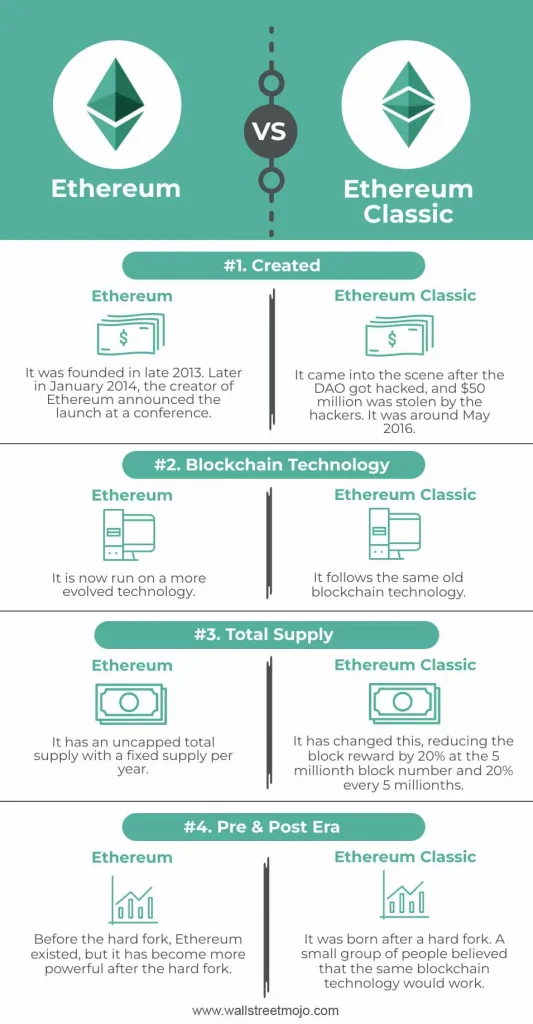Table of Contents
The key difference between Ethereum (ETH) and Ethereum Classic (ETC) is that ETC is a speculative digital asset with a fixed asset. On the other hand, ETH is the most extensively used and accepted version with an unlimited supply. Both emerged from a hard fork when Ethereum Classic was hacked in 2016.
Let’s get into a more detailed discussion about these both cryptos.
What is Ethereum Classic (ETC)?
In 2016, when the original Ethereum network was compromised, the blockchain split into two parts, among which one was Ethereum Classic and the other was the new Ethereum. Ethereum Classic is an open-source blockchain, and ETC is its native currency that fuels transactions and smart contracts on its network.
In addition to safeguarding the network, the hard fork led to the restoration of all the stolen funds to their rightful owners. Since the split, the Ethereum Classic network has undergone continuous improvements. Ethereum Classic’s fundamental goal focuses on immutability, popularly known as “code is law.”
Get WazirX News First
What is Ethereum (ETH)?
According to Ethereum.org, “Ethereum is a technology for building apps and organizations, holding assets, transacting and communicating without being controlled by a central authority. There is no need to hand over all your personal details to use Ethereum – you keep control of your own data and what is being shared. Ethereum has its own cryptocurrency, Ether, which is used to pay for certain activities on the Ethereum network.”
Ethereum is decentralized and accessible to everyone who has internet. Ethereum is a technology that can be used as a digital currency, worldwide payments, and application software.
You can use Ethereum’s DeFi system 24 hours a day, seven days a week, which means you can transfer funds, receive, borrow, and earn interest anywhere, anytime. However, you can also showcase any digital art in the form of an NFT with Ethereum.
Ethereum doesn’t force you to share your personal information, but all you need to have is a wallet. Although, in this internet era, we know somewhere we have to make our private data public.
How Ethereum and Ethereum Classic are different?
- Immutability
Immutability is a technique where users cannot make changes in the transactions that took place in the blockchain’s history.
Ethereum provides a platform where you can alter the transactions or make adjustments to them. However, Ethereum Classic uses the original Ethereum system that follows the concept of immutability.
- Mining process
For mining, Ethereum Classic still uses the Proof-of-Work (POW) system that Bitcoin also uses. To get rewards in the form of Ether, miners must validate transactions on the blockchain.
The new Ethereum has upgraded to a Proof-of-Stake (POS) process. Those who validate their transactions invest their stakes in the mining process to get the chance to add a fresh block to the chain and earn a reward.
- Limit
Ethereum can have an unlimited supply as and when needed, although the annual growth rate is restricted to 4.5%.
Ethereum Classic has a limited supply of 230 million tokens in total.
- Value
As of July 2022, the value of the Ethereum token is $1,088. It is also the second-largest crypto in the market, with a market cap of nearly $129 billion.
On the other side, Ethereum Classic is comparatively smaller, with a token value of $14 and a market cap of $1.9 billion, as of July 2022.
- Potential changes
While Ethereum is open to multiple potential future revisions, Ethereum Classic has decided to abide by Ethereum’s initial rules completely.

Does Ethereum Classic (ETC) have a future?
When we look at the future of Ethereum Classic, it doesn’t have a bright future, in all likelihood.
When we compare Ethereum Classic to Ethereum, it is self-evident to say that Ethereum is considered superior to Ethereum Classic. People trust the ETH network as it is more reliable, has more support, and has a greater market cap. Furthermore, as compared to any other smart contract platform, Ethereum has many DeFi platforms and other DApps built on it.
To make the issue worse, the Ethereum Classic network has experienced almost 51% of attacks. This usually happens if an attacker racks up sufficient hashing power to take over the majority of the network. Then, they can make changes in the blockchain, which might cause issues like double-spent transactions, where users can transfer the same coins more than once.
Bottom line thoughts
The key differentiating factor between Ethereum and Ethereum Classic is the ideology. The latter is dedicated to maintaining the fundamental code of the original Ethereum network. Those who want to prioritize Ethereum’s unadulterated historical record consider Ethereum Classic a worthwhile investment.

Disclaimer: Click Here to read the Disclaimer.






















